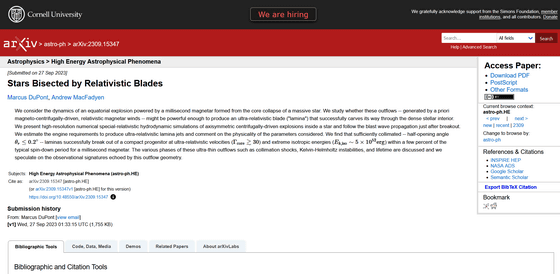A paper suggesting a ``plasma blade'' that cuts a star in half is published

[2309.15347] Stars Bisected by Relativistic Blades
https://arxiv.org/abs/2309.15347

Ultra-powerful plasma 'blades' could slice entire stars in half, new paper suggests | Live Science
https://www.livescience.com/space/astronomy/ultra-powerful-plasma-blades-could-slice-entire-stars-in-half-new-paper-suggests
A gamma ray burst is a phenomenon in which a celestial body emits gamma rays vigorously over a period of several seconds to several hours, and some disappear instantly, while others last for a relatively long time. The mechanism by which gamma-ray bursts occur is not clearly understood, but because a large amount of energy is required to cause a gamma-ray burst, when a supermassive star becomes a hypernova , it causes an explosion and creates a black hole. It is thought that this may occur during the formation of

'Relatively long-lasting gamma-ray bursts can occur during the formation of
When a huge star collapses due to its gravitational collapse and causes a supernova explosion , the central core of the celestial body is compressed, and as a result, it evolves into a celestial object called a neutron star. Neutron stars are celestial bodies with a diameter of several tens of kilometers and extremely high density and mass, but they can sometimes acquire extremely strong magnetic fields due to rapid compression and rotation. Neutron stars with this strong magnetic field are called magnetars .
Previously, it was thought that the magnetar's magnetic field would attract the remnants of surrounding stars, and that the powerful radiation and magnetic field would create plasma jets along the magnetar's axis of rotation. However, the research team also points out that the magnetar's magnetic centrifugal force may cause bursts of plasma to be irradiated along the equator.

This burst of irradiation becomes a plasma blade that moves toward the outside of the star, releasing more energy than a supernova explosion. Furthermore, this blade seems to have enough power to completely cut a high-density star in two.
This plasma blade loses momentum and disappears after traveling a distance several times the radius of the star, and the research team speculates that this is the true nature of gamma-ray bursts that last for a relatively long time. .
The research team's next challenge is to precisely study how the plasma blades ejected while cutting through the star dissipate, and how the magnetars that ejected the plasma blades change. Masu.
Related Posts:
in Science, Posted by log1i_yk







